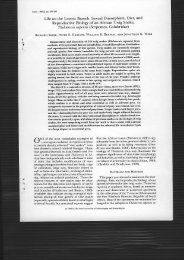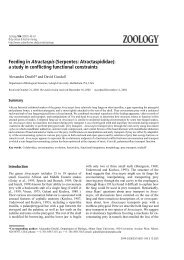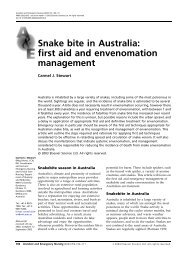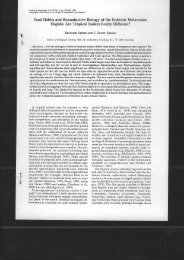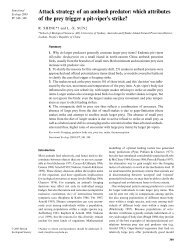Introduction - Kingsnake.com
Introduction - Kingsnake.com
Introduction - Kingsnake.com
You also want an ePaper? Increase the reach of your titles
YUMPU automatically turns print PDFs into web optimized ePapers that Google loves.
Clinical Management of Snakebite in Papua New Guinea Chapter 1<br />
mentioned in 40% of referral letters written by rural health workers, and 60% of the referred<br />
patients were found to have incoagulable blood upon admission to PMGH (Trevett et al,<br />
1994a). According to Trevett et al (1994a), a 20WBCT > 20 minutes had a positive predictive<br />
value (PPV) of 93.5% for a diagnosis of Papuan taipan (Oxyuranus scutellatus canni)<br />
envenomation. Williams et al (2003) reviewed 553 cases of snakebite from the Mekeo region<br />
in which the 20WBCT was used, and found that this simple diagnostic test had a positive<br />
predictive value of 98.4% and a specificity of 99.6% for the subsequent development of<br />
neurotoxicity. The PPV for subsequent coagulopathy was 67.7% with specificity of 95.7%;<br />
however, because the other signs and symptoms of incoagulable blood were often not<br />
reported in the clinical notes, it is probable that the actual PPV for disseminated intravascular<br />
coagulopathy is actually higher. In 60 fatal cases of snakebite reported by McGain et al<br />
(2004), 75% had a 20WBCT > 20 minutes and 35 patients (53.3%) had demonstrable<br />
spontaneous bleeding.<br />
Specific Indications of Envenomation: Myotoxicity<br />
There are few early reports of myotoxicity following snakebite in PNG, although some cases<br />
with ‘haemoglobinuria’ may actually have been patients with myoglobinuria instead. Blasco<br />
& Hornabrook (1972) mention that Ken Slater had ‘weakness’ after a bite from the smalleyed<br />
snake (Micropechis ikaheka), and this is often a sign of rhabdomyolysis. Hudson &<br />
Pomat (1988) report renal failure in 6 patients from Madang province who presented with<br />
dark-coloured urine. Hudson (1988b) reported two cases of presumed small-eyed snake<br />
(Micropechis ikaheka) envenomation. A 13 year-old girl bitten on the finger developed<br />
generalized muscle pain and tenderness and had urine that was dark reddish-brown, but was<br />
erythrocyte-free; and a 50 year-old man bitten on the finger while reaching into a bandicoot<br />
burrow by a ‘black-headed snake with a white belly’ also developed muscle pain and passed<br />
dark urine. This second patient’s muscle pain was mild initially but became more severe over<br />
the next 2 days; at Modilon hospital in Madang his urine was grossly discoloured, but once<br />
again was erythrocyte-free. He received one ampoule of death adder antivenom and three<br />
ampoules of polyvalent antivenom. Both patients were said to be anicteric and without<br />
coagulopathy, and had neurotoxicity; the 13 year old girl subsequently died. Other cases of<br />
presumed Micropechis ikaheka envenoming treated in Madang also showed signs and<br />
symptoms of generalized rhabdomyolysis and myoglobinuria. Warrell et al (1996) describes<br />
classical signs of myolysis (generalised muscle pain and tenderness; trismus; dark urine) in<br />
three patients with EIA proven small-eyed snake envenomation.<br />
The creatine kinase (CK) levels of 8 out of 12 patients bitten by death adders (Acanthophis<br />
spp.) was elevated (164-4,220 IU/L). Similar studies in victims of Papuan taipan (Oxyuranus<br />
scutellatus canni) bites found that creatine kinase levels were raised in 74.7% (43-8,110 IU/L)<br />
and levels of the liver enzyme aspartate transaminase (AST) were >50 IU/L in 52.6% of<br />
patients. Serum myoglobin exceeded 80 ng/ml in 52.2% of patients at the time of their<br />
admission. The serum creatine kinase levels of 2 of the 9 patients with proven Papuan<br />
blacksnake (Pseudechis papuanus) envenomation were slightly elevated; however there were<br />
no indications of rhabdomyolysis in any patient (Lalloo et al, 1994). In Australia, gross<br />
rhabdomyolysis and myoglobinuria after bites by members of the Pseudechis genus are<br />
relatively <strong>com</strong>mon, and creatine kinase levels may exceed 200,000 IU/L. Acute renal failure<br />
is a potential <strong>com</strong>plication of myotoxicity, and McGain et al (2004) reported muscle pain in<br />
41.7% of 60 fatal snakebites treated at PMGH. Renal <strong>com</strong>plications were contributing factors<br />
in the deaths of 16 (26.7%) patients. Testing for creatine kinase, lactate dehydrogenase and<br />
other isoenzymes that quantitatively measure rhabdomyolysis products is not routine in PNG<br />
at present so it is possible that this important syndrome is seriously under-reported.<br />
- 1.19 -




